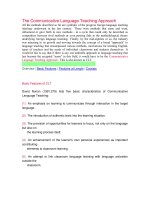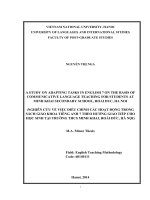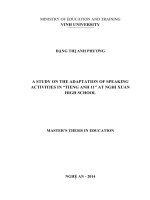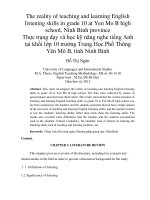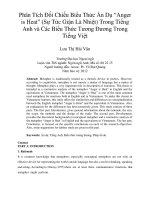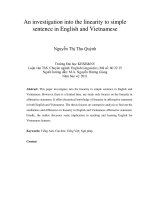Enhancing positive effects for the communicative language teaching activities in English classrooms
Bạn đang xem bản rút gọn của tài liệu. Xem và tải ngay bản đầy đủ của tài liệu tại đây (337.25 KB, 11 trang )
TRƯỜNG ĐẠI HỌC SƯ PHẠM TP HỒ CHÍ MINH
TẠP CHÍ KHOA HỌC
HO CHI MINH CITY UNIVERSITY OF EDUCATION
JOURNAL OF SCIENCE
KHOA HỌC GIÁO DỤC
EDUCATION SCIENCE
ISSN:
1859-3100 Tập 16, Số 8 (2019): 216-226
Vol. 16, No. 8 (2019): 216-226
Email: ; Website:
Research Article
ENHANCING POSITIVE EFFECTS FOR THE COMMUNICATIVE+
LANGUAGE TEACHING ACTIVITIES IN ENGLISH CLASSROOMS
Nguyen Van My
Ho Chi Minh City University of Education
Corresponding author: Nguyen Van My – Email:
Received: April 10, 2019; Revised: July 13, 2019; Accepted: July 18, 2019
ABSTRACT
Nowadays, most English teachers have widely applied the Communicative Language Teaching
activities (the CLT activities) in English classrooms as a foreign language (EFL) because of their
outstanding effectiveness. In spite of having many benefits for learning and teaching English,
activities in CLT also have problems with mixed-level students, un-motivated students and large class
sizes, as well as lack of language environment for foreign language acquisition. This article is about
how to enhance the positive effect for the CLT activities by using technology equipment. In this
article, the author reviews the crucial theory of the improvement effects for the CLT activities, and
therefrom practical activities are designed to teach English speaking skills.
Keywords: Communicative Language Teaching activities, mixed – level learners, student’s
learning motivations, technology equipment.
1.
Introduction
Understandably, most English teachers around the world have applied the CLT
activities in EFL classrooms. Many experts, however, have claimed that as mixed – level
learners, some of the learners may obtain more benefits from these tasks than others. In
addition, other critics have argued that the CLT activities are not enough to acquire a target
language (L2) because they are implemented only within a “monolingual community”.
As mentioned by Manag (2007), “within that wider community, we would need to
create a learning environment in which the classroom was less rigidly defined so that
students could reach into the target communities and contribute actively to meaningful
exchanges there”. Therefore, students should be immersed in target communities and
consequently, they would gain communicative competence in real-world situations.
It is obvious that linguistic environment plays an important role in the development of
language skills for non-native learners while acquiring foreign languages. According to
Cite this article as: Nguyen Van My. (2019). Enhancing positive effects for the communicative language
teaching activities in English classrooms. Ho Chi Minh City University of Education Journal of Science, 16(8),
216-226.
216
Tạp chí Khoa học Trường ĐHSP TPHCM
Nguyen Van My
Wang (2009), for the children, when exposure to the different languages, they not only
acquire their first language but also can acquire the foreign language. For those abroad or
mixed with speakers of another language, they have a pressing desire to communicate and
to get their meaning across. They have many opportunities to speak and experiment with the
language.
In other words, it is important for all learners to immerse in the target language (L2)
because non-native learners might have opportunities to practice interactively the target
language skills. However, most of the recent EFL classrooms often have poor language
environment condition for learners. Perhaps, adopting technology equipment in teaching
English is the best solution to these aforementioned problems because of several following
arguments.
Min (2013) proposes that the use of multimedia technology motivates students to learn
English. Instead of the traditional teaching methods that are unpopular and less effective in
the English language classrooms, multimedia technology, with the help of audio, visual and
animation effects, motivates students to learn English quickly and effectively. In addition,
with such features as abundant-information and crossing time and space, multimedia
technology creates a real-life or native speaking country context for English language
teaching.
It must be said in conclusion that the development of technology in this era makes
positive benefits for teaching English as a foreign language. In addition, it will certainly
continue to have more enormous achievements in the future. What follows is a general
overview of the approach of enhancing positive effects for an English lesson applied the
CLT activities, including some features of the CLT activities, as well as effectively raising
student motivations by adopting technology equipment keeping up with the Industry 4.0.
2.
Literature review
2.1. Understanding of the communicative language teaching activity
A lot of attempts have been made to provide an insight into the definition of the
communicative language teaching activity. According to Harmer (2010), “activities in CLT
typically involve students in real or realistic communication, where the successful
achievement of the communicative tasks they are performing is at least as important as the
accuracy of their language use”.
In his introduction to classroom activities in the CLT, Richards (2006) shows that the
CLT activities in classrooms includes two general types – “activities focusing on fluency”
and “activities focusing on accuracy”. In detail, activities focusing on fluency which reflect
natural use of language, focus on achieving communication, require meaningful use of
language, and produce language that may not be predictable. By contrast, activities focusing
on accuracy which reflect classroom use of language, focus on the formation of correct
examples of language, practice language out of context, or control choice of language.
217
Tạp chí Khoa học Trường ĐHSP TPHCM
Tập 16, Số 8 (2019): 216-226
Furthermore, Richards (2006) also divides activities in CLT into three different kinds
of practice – mechanical, meaningful, and communicative. Following this, mechanical
practice refers to a controlled practice activity which students can successfully carry out
without necessarily understanding the language they are using. Meanwhile, meaningful
practice refers to an activity where language control is still provided but where students are
required to make meaningful choices when carrying out practice. In addition, communicative
practice refers to activities where practice in using language within a real communicative
context is the focus, where real information is exchanged, and where the language used is
not totally predictable.
In 2001, Richards & Rodgers mention the major activity types – functional
communication activities and social interaction activities in the communicative language
teaching. According to these authors, functional communication activities include such tasks
as learners comparing sets of pictures and noting similarities and differences; working out a
likely sequence of events in a set of pictures; discovering missing features in a map or
picture; one learner communicating behind a screen to another learner and giving
instructions on how to draw a picture or shape, or how to complete a map; following
directions; and solving problems from shared clues. Social interaction activities include
conversation and discussion sessions, dialogues and role plays, simulations, skits,
improvisations, and debates.
2.1.1. Advantages of the communicative language teaching activity
As mentioned by Richards (2006), most of the CLT activities involving pair and group
work, have many benefits for EFL students. In the grouping activities, students can learn
when listening to other students in the group. Students are able to produce more output that
they would utter in teacher-centered instruction, they can be engaged in speech because they
feel more comfortable speaking to their peers, and they can develop fluency.
In their seminal paper of 2004, Nguyen & Nguyen suggest that the communicative
approach has the ability to help learners study and practice not only communicative skills
but also grammar patterns. Besides, these authors claimed that communicative lessons are
more effective than grammar-translation lessons in helping learners raise their ability to
produce statements correctly and appropriately. Learners were more motivated when they
experienced more interesting and active communicative grammar lessons than their friends
did in the control class.
The implementation of CLT has brought a lot of advantages for Teaching English as a
foreign or a second language. As concluded by Richards (2006), unlike audio-lingual and
grammar-translation methods, communicative teaching emphasis on “task-oriented, studentcentered” language teaching practice and creates a positive environment for the classroom
activities such as group discussion, subject discussion and debates, which can other more
opportunities for communication among students and between teachers and students. In
218
Tạp chí Khoa học Trường ĐHSP TPHCM
Nguyen Van My
other words, it makes the “linguistic environment” for students to practice the four English
skills.
2.1.2. Disadvantages of the communicative language teaching activity
When discussing problems of the communicative language teaching activity in English
classrooms, Thamarana (2015) have come to the conclusion that activities in the CLT
approach are great for intermediate students and advanced students, but for beginners, some
controlled practice is needed. According to the author, students with low levels of
proficiency in the target language may find it difficult to participate in oral communicative
activities and, if the exams used by any institution are grammar based, communicative
fluency may not be appropriate.
In addition, Richards (2014) concludes that the unfavorable class-size, especially,
classes of 50 or more students are very popular in some countries making opportunities for
authentic communication difficult. Large class sizes tend to favor receptive activities
involving reading and listening because they are less demanding and time-consuming for the
teacher than productive activities involving speaking and writing in pairs or groups.
As a result, the teacher-centered instruction that does not provide students with critical
unrehearsed language practice and individual attention. The combination of grammar-based
instruction, the limited oral interaction of students in the class, and inadequate opportunities
to speak English outside of class with foreigners or to travel abroad does not support the
development of communicative competence.
Another problem is the fact that students may feel too shy or embarrassed to speak in
class or perform in front of an audience, especially in English. “This type of performance
anxiety and other feelings students have in the language learning process have long been an
important consideration in ELT” (Harmer, 2010, p. 91).
2.2. Solutions to the problems of the communicative language teaching activity in
English classrooms
In the following section, some of the solutions to these problems, including raising
student motivations and applying the technology equipment in English classrooms, will
particularly be provided. This attempt is best wished to enhance the positive effects for the
communicative language teaching activities in English classrooms.
2.2.1. Raising student motivations
We absolutely know that an effective English lesson depends not only on the teaching
approach but also on student learning motivation. A reasonable explanation for this argument
may be that when students come to class, they bring with them their own personalities and
their own learning expectations. “Their behaviors will also be influenced by their current
circumstances and by what happens in the lessons. There is always, as well as, the possibility
of interpersonal tensions between students, or between students and their teacher” (Harmer,
2015, p. 93).
219
Tạp chí Khoa học Trường ĐHSP TPHCM
Tập 16, Số 8 (2019): 216-226
Harmer (2015) also mentions that writers on motivation divided the motivations into
extrinsic and intrinsic. In particular, extrinsic motivation is from outside the leaners
themselves and may, for example, be provoked by the need- or the desire – to pass an exam,
or by the fact that the learner has a trip to a foreign country and needs to get their language
up to a communicatively efficient level. In addition, intrinsic motivation is described as a
“passion for learning” and “a sense of competence while performing challenging tasks”.
Students who are intrinsically motivated are driven by a desire to succeed in class and by
what happens in the lesson.
Therefore, the primary function of teachers’ management role is to motivate the
learners who are demotivated and to nurture who are already well motivated to the task of
learning a foreign language.
2.2.2. Applying the technology equipment in English classrooms
Today, one of the most popular personal devices is the mobile phone which can be
used for recording and playing multimedia contents. Students can greatly benefit from
having a camera on the cell phones for documenting visual materials and collecting scientific
data. Additionally, browsing with cell phones is one convenient way for students to surf
online. Most of the modern mobile phones are incorporated with browsing applications such
as Opera Mini, Internet Explorer, Mozilla Firefox, Opera, and Google Chrome. Mobile
phones have the downloading feature which can be used by students and tutors to download
various kinds of materials through their mobile phones easily. Teachers can download video
through their mobile phones and present them to students through a TV set available in the
classrooms.
In order to create a linguistic environment for foreign language acquisition, one of the
effective solutions is to use English videos available on the Internet in the English lesson.
According to Harmer (2015), watching films can help students see how intonation matches
facial expression and what gestures accompany certain phrases. Following this way, students
can adjust themselves their pronunciation followed the English speakers.
Along with the problems of the CLT activities, including mixed-level students,
unmotivated students, and large class sizes, English teachers might use tape recorders or
other audio recording devices in helping students overcome their difficulties in the English
speaking skills front of the class. According to Armstrong (2000), tape recorders or other
audio recording devices, including some software, are among the most valuable learning
tools in any classroom. This is because they offer students a medium through which to learn
about their linguistic powers and help them employ verbal skills to communicate, solve
problems, and express inner feelings.
The most noticeable feature of Industry 4.0 is the development of Artificial
Intelligence (AI). The AI is applied popularly in many fields of modern life, including
aspects of the English language because of its special effects. According to Hilfer (2018),
220
Tạp chí Khoa học Trường ĐHSP TPHCM
Nguyen Van My
“AI and machine learning have great potential to provide targeted speaking practice for many
adult learners. Machine learning has long been the cornerstone of speech recognition for the
automation of speaking instruction and targeted pronunciation training.”
As mentioned above, students may feel embarrassed to speak or perform in front of
the class, especially in English classrooms. Fortunately, Artificial intelligence might be the
best solution in this situation. McClure (2018) points out that the AI enables the digital
courseware to address the individual needs of learners at a level that is difficult to achieve
in a classroom. In particular, the AI allows students to choose appropriately English courses
for their individual needs, as well as identifies students’ weaknesses so that they receive
extra presentation and practice of those concepts and content.
From some above illustrations, engaging the technology equipment in English
classrooms is the effective solution to the problems of the CLT activities. In addition, we
can conclude that a noticeable challenge for English teachers is to use effectively advantages
of technology equipment in teaching English keeping up with the Industry 4.0.
3.
Procedure
The following is to describe a particular lesson using mobile phones and social
networks to support the implementation of the CLT activities in English classrooms. In this
situation, students will work in groups and complete a learning project (making a video about
their family).
3.1. Background information
Learning objectives: The purpose of the lesson is for students to
Improve the four English skills, but speaking skills is in priority
Work in groups of five or seven students
Make a speech in about 10 – 15 minutes
Student level: The lesson should take place after students had exposure to the basic
structure of the English language, including the descriptive adjectives, and simple sentence
structures. The lesson is best used in the context of pre-intermediate English language
learners
Class size: The lesson can be implemented in large sized classes from 30 to 40 students
Organization: individual, groups, and the whole class
Language focus: Descriptive adjectives, Simple sentence structures
Alternatives: Review on the English tenses, including the present tenses and past
simple tense
Teaching method: Communicative language teaching (CLT), including main activities
such as Task-completion activities, Opinion-sharing activities, Information-transfer
activities, Roleplays, or Project-based activities
Technology equipment: Mobile phones, social networks, and apps for teaching and
learning English
221
Tạp chí Khoa học Trường ĐHSP TPHCM
Tập 16, Số 8 (2019): 216-226
3.2. The implementation of the lesson in English classrooms
Particularly, the lesson might be implemented following steps
Step 1: Teachers divide the class into groups. In each group includes from 5 to 7
students
Directions to Students: Work in groups of five to seven students
1 The topic for this lesson is Talking about your family
2 Each person in the group must have a job to do. Using Table 1, write the names of
everyone in the group and what each person will do
Table 1. The task template of each student in groups
Name:
What this person will do:
A
B
C
Step 2: In the class, teachers show video models of native speakers about this topic.
Similar videos are available on the Internet, retrieved from some websites
(, or www.youtube.com). Teachers can choose some of them that are
suitable for the learning content of the lesson. Based on what students saw in the video, they
can outline something necessary to complete in this project, as well as practice their listening
skills
Step 3: In the class, teachers ask students to practice in pairs. In this way, students
create dialogues following some available questions provided by the teacher
Where are you from?
How many people are there in your family?
What does your father/mother/sister look like?
What is your father/mother/sister like?
What activities do you often do with your family?
This activity enables students to practice interactively their speaking skills in pairs
before they work in groups to complete their projects (making a video about their family at
home).
Step 4: Individually, teachers let students make a small talk about their family. In this
step, students will make an outline of the speech using linguistic materials in the last lessons.
Teachers call some of the students to speak in front of the class. At the same time, others
must listen to their friends carefully and give feedbacks
222
Tạp chí Khoa học Trường ĐHSP TPHCM
Nguyen Van My
Step 5: In the out of class learning, teachers ask students to work in groups and make
a video recording about the topic “Talking about your family”
Directions to Students:
1.
Each group will make a video with the length from 10 to 15 minutes;
2.
All students in the group will have participated in this video;
3.
Students must apply something learned in the lesson to their speaking, including
descriptive adjectives, and simple sentence structures;
4.
Ideas for mobile phone video projects: Students can consider ideas to make a
video about the family topic with their mobile phones. To begin, they can get ideas from
many popular programs on television, including talk shows, game shows, news specials, and
parodies.
To support the process of making videos, students can use some special functions at
websites
namely
movie/TV
scripts
creations
(www.script-o-rama.com,
www.simplyscripts.com),
or
text-to-speech
programs
creations
(www.research.ibm.com/tts/coredemo.shtml).
Step 6: After completing their projects, each of the groups will have uploaded their
video projects on the website .1
Step 7: Each of the groups will have evaluated videos, uploaded on the website:
, following the video assessing rating (see Appendix A)
Based on what evaluated from the groups, teachers can choose the most interesting
videos to show in front of the class in the next lessons, and ask the chosen groups to make a
presentation about their videos.
4.
Discussion
Through an analysis of implementation the aforementioned example, we found that
there are many positive effects for English classrooms applied activities in CLT. One of the
most outstanding effects is that this example can be applied in an unfavorable class-size. It
might encourage all students to participate in group projects. All students in the class have
opportunities to practice their speaking skills. Furthermore, the activities in this example can
engage students in an in-depth inquiry. This means that students are engaged in a rigorous,
extended process of asking questions, using resources, and developing their ideas when
working in groups.
Most of the CLT activities involving pair and group work, as it can be seen in the
above example, have many benefits for EFL students. In the grouping activities, students
1
This website allows teachers to make connecting classrooms by email addresses that can help managing
student tasks effectively. When using this website, teachers can establish deadlines for each particular task, as
well as handle the task completion of students. In addition, this makes an interactive learning environment
because students can comment something about their tasks or others. In conclusion, these network tools can help English
teachers carry out this activity conveniently. Teachers can evaluate the task effectiveness of students and encourage the
active participating from students in the class.
223
Tạp chí Khoa học Trường ĐHSP TPHCM
Tập 16, Số 8 (2019): 216-226
can learn when listening to other students in the group. Additionally, students can develop
21st-century skills, students build skills valuable for today’s world, such as critical thinking,
problem-solving, collaboration, and communication, which are taught and assessed.
In addition, with the support of mobile phones and social networks, students have more
opportunities to practice their speaking skills out of the class by recording their voices.
Moreover, they can be more interactive with others when uploading their records on the
social network as the example above. In particular, students can give their feedback in a
comfortable way, as well as receive some comments for their speaking from others in the
class. This is the best solution to barriers of the CLT activities that unmotivated students
who are too embarrassed or refuse to participate in class activities. As reported by Harmer
(2010), uncooperative and unmotivated students are a serious problem and can easily disrupt
the instructional process in this way.
However, depending on detailed features of each English class, teachers can use other
social networks to support the English teaching (see Appendix B). We need more studies
about the effects of the social networks on learning and teaching English in the future.
5.
Conclusions
This article discusses how to enhance the positive effect of the communicative
language teaching activity in English classrooms, including raising student motivations, as
well as adopting technology equipment. In order to improve the effects of activities in CLT,
English teachers need to keep up with the development of technology equipment to design
more effective and creative English lessons. This is increasingly becoming a vital factor in
helping students to develop the four– English skills and more ready to face the changes from
Industry 4.0.
Conflict of Interest: Author have no conflict of interest to declare.
REFERENCES
Armstrong, T. (2008). Multiple intelligences in the classroom (3rd ed.). Retrieved from
/>Harmer, J. (2015). The Practice of English Language Teaching (5th ed.). Harlow, UK: Pearson
Education Limited.
Hilfer,
E.
(2018).
The
Agency
of
Artificial
Intelligence.
Retrieved
from
/>McClure, K. (2018). The Agency of Artificial Intelligence. Retrieved from
/>
224
Tạp chí Khoa học Trường ĐHSP TPHCM
Nguyen Van My
Magnan, S. S. (2007). Reconsidering Communicative Language Teaching for National Goals.
Modern Language Journal, 91(2), 249-252. Retrieved from />Nguyen, Q. G., & Nguyen, T. N. H. (2004). Applying Communicative Methods to teaching
Grammar: An Experiment. Teacher’s Edition: Proceedings of an international conference
held
in
Vietnam,
March
2004
(pp.
16-20).
Retrieved
from
/>Pun, M. (2014). The Use of Multimedia Technology in English Language Teaching: A Global
Perspective. Crossing the Border. International Journal of Interdisciplinary Studies, 1.
10.3126/ctbijis.v1i1.10466
Richards, J. C. (2014). The Changing Face of Language Learning: Learning Beyond the Classroom.
RELC Journal, 1-18. Retrieved from />Richards, J. C. (2006). Communicative Language Teaching Today. New York, USA: Cambridge
University Press.
Richards, J. C., Rodgers, T. S. (2001). Approaches and methods in language teaching (2nd ed.).
Cambridge, UK: Cambridge University Press.
Thamarana, J. (2015). A Critical Overview of Communicative Language Teaching. International
Journal of English Language, Literature and Humanities, 3(5), 90-100.
/>tive_Language_Teaching.
Wang, C. (2009). On Linguistic Environment for Foreign Language Acquisition. Asian Culture and
History, 1(1), 58-62.
Retrieved from
/>
APPENDIX
APPENDIX A
VIDEO RATING RUBRIC
Topic:_________________________________Group’s name: ______________________
Examiner’s name: _______________________Leader’s name: _____________________
Instructions: Evaluate each criterion below by sticking () the corresponding number using
the following five-point scale:
EVALUATION CRITERION Needs improvement Fair Good Very good Excellent
(1)
(2)
(3)
(4)
(5)
Quality of video script
Acting
Video content
Video organization
Video pacing
Overall effectiveness
225
Tạp chí Khoa học Trường ĐHSP TPHCM
Tập 16, Số 8 (2019): 216-226
Additional comments:
__________________________________________________________________________
_______________________________________________________________________________
_______________________________________________________________________________
_______________________________________________________________________________
APPENDIX B
SOCIAL NETWORKS, APPS, WEBSITES SUPPORTING LEARNERS IN
LEARNING ENGLISH
Social networks & Supporting websites
Language Apps
for students to use on smartphones
1. Facebook, Zalo
1. Duolingo – language courses
2. ;
2. HelloTalk – chat and Q&A
3. www.youtube.com;
3. HiNative – chat and Q&A
4. ;
4. Mindsnacks – language games
5. www.script-o-rama.com;
5. Memrise – flashcards and SRS
6. www.simplyscripts.com;
6. Leaf – context and idioms
7.www.research.ibm.com/tts/coredemo.shtml 7. Lingua.ly – native reading and materials
8. Busuu – language courses
NÂNG CAO HIỆU QUẢ CỦA CÁC HOẠT ĐỘNG DẠY HỌC THEO PHƯƠNG PHÁP
GIAO TIẾP TRONG CÁC LỚP HỌC TIẾNG ANH NHƯ MỘT NGOẠI NGỮ
Nguyễn Văn Mỹ
Trường Đại học Sư phạm Thành phố Hồ Chí Minh
Tác giả liên hệ: Nguyễn Văn Mỹ – Email:
Ngày nhận bài: 10-4-2019; ngày nhận bài sửa: 13-7-2019; ngày duyệt đăng: 18-7-2019
TÓM TẮT
Ngày nay, phần đông các giáo viên tiếng Anh vận dụng phương pháp giao tiếp vào các giờ
học tiếng Anh như một ngoại ngữ vì những ưu điểm nổi bật của phương pháp này. Tuy nhiên, bên
cạnh những ưu điểm, phương pháp giao tiếp cũng tồn tại những bất cập nhất định liên quan đến sự
đa dạng trình độ và động cơ học tập của học sinh, lớp có sĩ số đông, và cả việc thiếu môi trường
thực hành ngoại ngữ thường xuyên. Trong bài viết này, tác giả đi sâu phân tích một số quan điểm lí
thuyết về những ưu điểm và nhược điểm, cũng như một số giải pháp khắc phục nhược điểm khi áp
dụng phương pháp giao tiếp, thông qua việc sử dụng các thiết bị công nghệ và nâng cao động cơ
học tập của học sinh. Dựa trên nền tảng lí thuyết này, tác giả minh họa cụ thể các hoạt động thực
hành dùng để giảng dạy kĩ năng Nói tiếng Anh cho đối tượng học sinh có trình độ tiếng Anh cơ bản.
Từ khóa: đa dạng trình độ người học, động lực học tập, hoạt động dạy học tiếng Anh giao
tiếp, thiết bị công nghệ.
226
